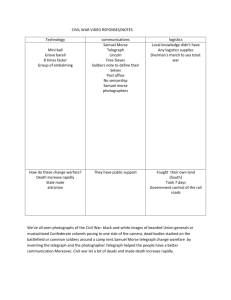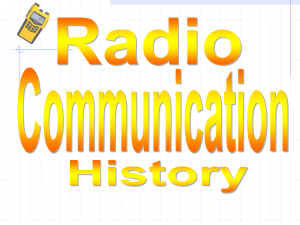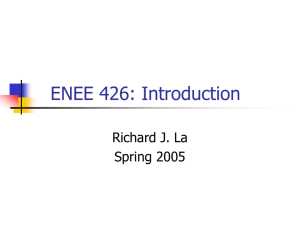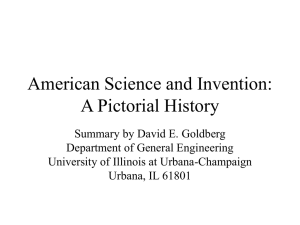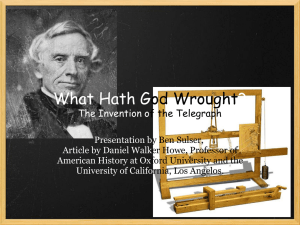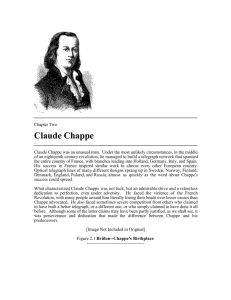The Use of Optical Telegraphs in England and Elsewhere
advertisement
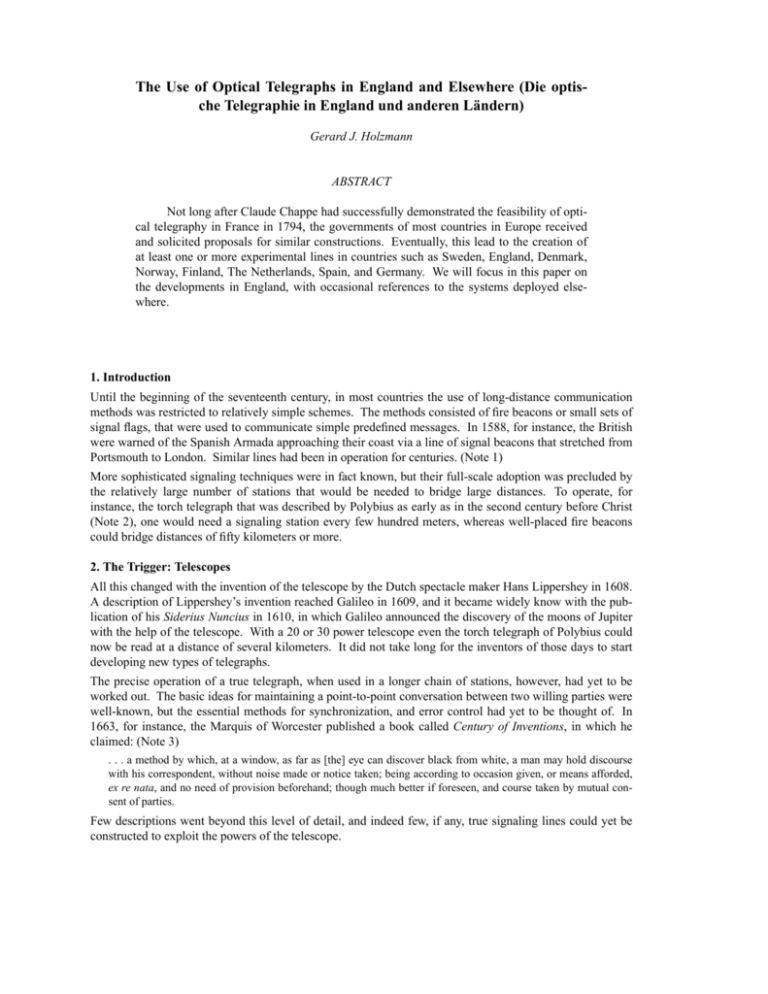
The Use of Optical Telegraphs in England and Elsewhere (Die optische Telegraphie in England und anderen Ländern) Gerard J. Holzmann ABSTRACT Not long after Claude Chappe had successfully demonstrated the feasibility of optical telegraphy in France in 1794, the governments of most countries in Europe received and solicited proposals for similar constructions. Eventually, this lead to the creation of at least one or more experimental lines in countries such as Sweden, England, Denmark, Norway, Finland, The Netherlands, Spain, and Germany. We will focus in this paper on the developments in England, with occasional references to the systems deployed elsewhere. 1. Introduction Until the beginning of the seventeenth century, in most countries the use of long-distance communication methods was restricted to relatively simple schemes. The methods consisted of fire beacons or small sets of signal flags, that were used to communicate simple predefined messages. In 1588, for instance, the British were warned of the Spanish Armada approaching their coast via a line of signal beacons that stretched from Portsmouth to London. Similar lines had been in operation for centuries. (Note 1) More sophisticated signaling techniques were in fact known, but their full-scale adoption was precluded by the relatively large number of stations that would be needed to bridge large distances. To operate, for instance, the torch telegraph that was described by Polybius as early as in the second century before Christ (Note 2), one would need a signaling station every few hundred meters, whereas well-placed fire beacons could bridge distances of fifty kilometers or more. 2. The Trigger: Telescopes All this changed with the invention of the telescope by the Dutch spectacle maker Hans Lippershey in 1608. A description of Lippershey’s invention reached Galileo in 1609, and it became widely know with the publication of his Siderius Nuncius in 1610, in which Galileo announced the discovery of the moons of Jupiter with the help of the telescope. With a 20 or 30 power telescope even the torch telegraph of Polybius could now be read at a distance of several kilometers. It did not take long for the inventors of those days to start developing new types of telegraphs. The precise operation of a true telegraph, when used in a longer chain of stations, however, had yet to be worked out. The basic ideas for maintaining a point-to-point conversation between two willing parties were well-known, but the essential methods for synchronization, and error control had yet to be thought of. In 1663, for instance, the Marquis of Worcester published a book called Century of Inventions, in which he claimed: (Note 3) . . . a method by which, at a window, as far as [the] eye can discover black from white, a man may hold discourse with his correspondent, without noise made or notice taken; being according to occasion given, or means afforded, ex re nata, and no need of provision beforehand; though much better if foreseen, and course taken by mutual consent of parties. Few descriptions went beyond this level of detail, and indeed few, if any, true signaling lines could yet be constructed to exploit the powers of the telescope. 3. Hooke’s Device A seminal contribution came in 1684. On 21 May 1684, the Englishman Sir Robert Hooke (1635–1703) held a lecture for the Royal Society titled On Showing A Way How To Communicate One’s Mind At Great Distances. (Note 4) In his lecture, Hooke described a simple device that works with the help of telescopes, but for the first time ever he details a general method for operating telegraphic devices reliably. Hooke’s telegraph consisted of a wooden framework from which large cut-out symbols could be displayed. There are three major innovations in Hooke’s description of the general use of this device. First, in Hooke’s description the symbols do not represent the letters from the alphabet, as most others had proposed earlier, instead they represent abstract codes of which the meaning is defined in a vocabulary. Second, in Hooke distinguishes carefully between the use of data or message symbols and the use of control symbols. The latter carry no message information but they serve to control the data exchange itself. Hooke stipulates that control symbols are to displayed above the frame of his telegraph, and the data symbols are to be displayed below it. Thirdly, and most importantly, Hooke for the first time ever proposes explicit rules of protocol for the transmissions. This is how Hooke explained the last two points: There will also requisite several other characters, which may, for expedition, express a whole sentence, to be continually made use of, whilst the correspondents are attentive and communicating. The sentences to be expressed by one character [symbol] may be such as these [...]. I am ready to communicate [synchronization]. I am ready to observe [idem]. I shall be ready presently [delay]. I see plainly what you shew [acknowledgement]. Shew the last again [an error code]. Not too fast [rate control]. Shew faster [idem]. Answer me presently. Dixi [I have spoken, i.e., end-of-text]. Make haste to communicate this to the next correspondent [priority]. I stay for an answer; and the like. All which may be expressed by several single characters, to be exposed on the top of the poles [instead of suspended below them, like the characters for message data], by themselves [...] so as no confusion may be created thereby. It appears that, apart from a single experiment with telegraphs mounted on opposite sides of the Thames river in London, Hooke’s telegraph was never used in practice. His description, though, was known to most later inventors, including to Claude Chappe in France, and his insights must have eased the way for them. 4. The Dollond Telescope For another century no further progress was made. The next push forward was again inspired by improvements in telescope design. The early telescopes were expensive and had to be quite long to give sufficient magnifications. Tubes lengths of several meters were no exception. As a result, the images produced by these telescopes were dim. The image could be made brighter by increasing the ratio of lens diameter to tube length, but only at the expense of image quality. In 1747, Leonhard Euler (1707–1783) found a way to use the flaws of one lense to correct those of another, by using multiple lens elements in a more compact design. Shortly afterwards, in 1750, the Swede Samuel Klingenstjerna (1698–1765) made an extensive study of the color separation properties of different types of glass, and in 1757 all this new knowledge was combined in the construction of the so-called ‘‘Dollond telescope,’’ by the Englishman John Dollond (1706–1761), with much improved image quality and resolution. It became the standard for many years to come, and was used in the optical telegraphic systems that followed within a matter of years. The availability of the Dollond telescopes made a critical difference in the feasibility of optical telegraphy. 5. Sir Edgeworth’s Tellograph One of the first new experiments was performed by an Irish landowner named Sir Richard Lovell Edgeworth (1744–1817). Edgeworth first designed his telegraph in 1767. (Note 5) It consisted of a single large pointer that could be rotated in 45 degree increments. Each of the eight possible positions of the pointer indicated a signal element. Two subsequent elements could indicate a choice of one of 64 possible codes; three subsequent elements gave a choice of one of 256 codes, etc. An experiment with this Tellograph, as it was named by Edgeworth, was described in a newspaper from August 1794, as follows: The index has eight different situations in the circle it describes signifying the eight figures (0, 1, 2, 3, 4, 5, 6, 7). The person at the corresponding station taken fifteen miles off can thoroughly perceive by the help of a good telescope, every situation of the index and each party at each station is furnished with a glossary or a dictionary to explain the signals; thus the ideas of one may be in a few minutes communicated to the other. This newspaper report was triggered by the first news of Claude Chappe’s successes in France with an optical telegraph line. Despite a strong lobby, and an offer to carry all the necessary expenses, Edgeworth did not succeed in persuading the Irish government to install a line of Tellograph stations in Ireland. So the issue of telegraph design was allowed to lay dormant in England for a few more years, until the developments in France started making headlines all over Europe. In 1795 the British Admiralty still ordered the construction of 48 traditional signal towers along the south coast of England, from Sheerness to Land’s End, but that same year it also received and approved a proposal by Lord George Murray (1761–1803) to build a first optical telegraph line. Murray’s proposal was a variation of a Swedish design that was due to Abraham Niclas Edelcrantz. 6. Lord Murray’s Shutter Telegraph In 1794, Edelcrantz had disclosed a design of a ten-shutter telegraph for signaling along the Swedish coastline. (Note 6) Murray, who almost certainly had seen or heard about this work, proposed a minor variation of this system, using six instead of ten shutters. Murray’s design had two columns, each with three octagonal shutters. Six shutter were sufficient to produce 26 or 64 signal combinations; far fewer than the 210 or 1024 from Edelcrantz’s design, but deemed sufficient. The motivation for this choice was summarized in one of the first articles on optical telegraphy that appeared in the Encyclopaedia Britannica of 1797: This telegraph [Murray’s] is without doubt made up of the best number of combinations possible; five boards [shutters] would be insufficient, and seven would be useless. The article continues with a small note of caution, reflecting that the Murray’s telegraphs had its critics: It has been objected to it, however, that its form is too clumsy to admit of its being raised to any considerable height above the building on which it stands; and that it cannot be made to change its direction, and consequently cannot be seen but from one particular point. Edelcrantz, who soon heard about the competing British design, also criticized it, in a booklet on optical telegraphy that he published in Stockholm in 1796. He wrote: It is easily seen that this device, which as far as the shutters are concerned is similar to the one I have described . . ., and which I reported and realized as early as in 1794, is otherwise quite different. All other telegraphs usually require at least one signal per letter. This system seems to require two separate signals in order to express every letter in the alphabet, and in consequence appears twice as slow as ordinary telegraphs, but six times as slow as those telegraphs where one signal can indicate syllables of three or four letters. A little later, Edelcrantz also casts his doubts about the proper construction of the British copy of his design: This machine [Murray’s], the external or internal construction of which I know nothing about, does not seem to be build in such a manner that the shutters can show against the sky. Since the shutters are also fairly close to each other, it must encounter great problems from the shimmering of the air, both when the air is clear and when it is not. The British Admiralty nonetheless accepted Murray’s design and constructed a first line of 15 stations, going east from London via Chatham to Deal, with a branch north from Faversham via Tonge to Sheerness. The line was completed on 27 January 1796. (Note 7) Signals could be sent via this line from London to Deal in about one minute. The line was extended later in 1796 with 10 additional stations from London via Beacon Hill south to Portsmouth, effectively replacing the traditional line of signal-stations along that route. In the early years of the nineteenth century, construction of new lines was delayed somewhat after the signing of the Peace of Amience removed the threat of a French invasion temporarily. By 1806, however, the construction of optical telegraph stations was revitalized. In that year another 22 stations were added to the growing network, leading from Beacon Hill 200 miles southwest to Plymouth. In 1807 another line of 18 stations from London via Hampstead north to Great Yarmouth was added. By 1808 a total of 65 optical telegraph stations were in operation, all based on Murray’s shutter design. George Murray’s design remained in active use until circa 1816. Perhaps as a result of frustration with the limitations of Murray’s system, over 100 new designs for telegraphs were submitted to the British Admiralty and the British Parliament between 1796 and 1816. The counter-proposals had started as early as in 1795, when Murray’s plans first received some publicity. One of these counter-proposals, for instance, was submitted by John Gamble, otherwise employed as chaplain to members of the royal family. Gambles design was reminiscent of Edgeworth’s, using radial arms. But it, like all the others, was rejected by the admiralty, saying they were: . . . so well satisfied with the telegraphs erected under the direction of Lord George Murray that they did not think it necessary to make any experiment with the radiated form. Sir Edgeworth, who similarly had no success with his own proposals at the British Admiralty, started to lobby the British Parliament in the same period. He was only slightly successful there. In 1804 parliament accepted Edgeworth’s Tellograph design, but it then failed to follow-up by securing the funds for the construction of any lines. George Murray died in 1803, just 42 years old, and could no longer defend his design to the flow of criticism of competing inventors. In 1816, the British Admiralty yielded to the critics and adopted a design from the British Admiral Sir Home Riggs Popham (1762–1820) to replace Murray’s system. 7. Admiral Popham’s Two-Armed Telegraph Curiously, Popham’s design looks closer to Edgeworth’s Tellograph design than either Chappe’s semaphore or Murray’s shutter telegraph. His design consisted of two movable arms that could be placed in one of seven positions, allowing 72 = 49 different signals. The design was meant to be used both on land, as Murray’s system, and on ships, where until then only flag signaling systems had been used. The design with rotating arms had meanwhile also reached France, where not withstanding Chappe’s success with the semaphore telegraph, starting in 1801 the French had put in place a coast signaling system consisting of a mast with three indicator wings attached. In that system, each wing could be placed in eight possible positions, like the Tellograph. This system is traditionally attributed to the Frenchman C. Depillon. Around 1807 the Depillon telegraph had been installed along the coast from Vlissingen in the Netherlands to Bayonne in France, and could easily have inspired Popham when he made his proposal to the British Admiralty in 1816. (Popham, after all, was an admiral, and could have seen the Depillon telegraphs in operation for many years whenever his fleet approached the European coastline.) Apparently, there was still a lingering doubt that the telegraph designs could be improved. After Napoleon’s defeat at Waterloo in 1815, France and England were on better terms, and in 1819 the English ambassador to France requested the French government to give England a model of the Chappe telegraph. This was promptly done, but intentionally or accidentally, no instructions or code tables were included, and so very little could be learned from it. A trial was done with a Chappe telegraph installed at Nunhead for a brief period of time, but it was soon replaced with Popham’s design. 8. Colonel Pasley’s Improvement In 1822 Popham’s design was revised by Colonel (later General) Charles W. Pasley (1780–1861). The new system still had two movable arms, but this time each arm could be set in one of eight positions, producing 8×8 or 64 code combinations, and of course resembling the Depillon system even closer. The upper arm in Pasley’s design had a fixed V-shape, to make it easier to distinguish it. Pasley’s telegraph was used to reconstruct, for instance, the line from London to Portsmouth, which had been abandoned in 1816. The new line from London to Portsmouth was in operation from 1822 until 1847. A start was also made with the reconstruction of the branch to Plymouth, this time starting not at Beacon Hill but at a station called Chatley Heath, close to London on the new London to Portsmouth line. Construction on the branch to Plymouth started in 1825, but it was suspended in 1831 and never resumed. The use of the Pasley system, however, survived much longer still on ships. Its use, for instance, was reported during a review of the fleet at Spithead by Queen Victoria prior to its departure to the Crimean War in 1859. The historian David Woods noted: The Royal Navy retained mechanical semaphores aboard ship until 1943. The only difference from Pasley’s signal design was the elimination of his subsidiary ‘indicator’ arm [i.e., only the V-shaped arm was used]. 9. Lieutenant Watson’s Decimal Telegraph One last significant improvement in the design of the optical telegraphs took place in England in 1827. In that year, reserve Marine Lieutenant Barnard L. Watson constructed a commercially operated line of 11 stations connecting Liverpool along the coastline westward to Holyhead. The line was in operation until 1860. Watson’s design consisted of a single support column with three indicator pairs mounted at the top. Each of the three indicators could be set in one of ten positions, allowing a simple decimal encoding of signals. Watson defined nine code groups, each of 1,000 signals. A first signal of each series would be used to select the required signal group, or code book. 10. Influence on Other Countries Optical telegraph designs were used in many other countries, both in Europe and elsewhere. The Chappe telegraph design was undeniably the first, and the most significant trigger for all later developments. But curiously, few of the other countries would adopt the Chappe system. There were a few exceptions, most notably in Russia. In 1833, for instance, the frenchman Jacob Chateau was commissioned to design an optical telegraph link between the Winter Palace in St. Petersburg and Kronstadt. Two years later, two more lines, from the palace St. Petersburg to palaces in Tsarskoje Selo and to Hatsina were added. The system, a minor modification of the Chappe telegraph, was apparently so successful that in 1836 construction began on a line of 220 Chappe telegraphs connecting St. Petersburg to Warsaw. That line was completed in 1839. (Note 8) In comparison, both the Swedish shutter design and the English two- or three-armed semaphores had a much greater influence on the designs that were adopted elsewhere. The following sections give a brief overview of the influence of these two systems on the other countries, as far as it can still be traced today. 10.1 Germany In December 1830, Watson’s design was chosen by Postrat Carl Pistor (1778–1847) in Germany to construct the first line of optical telegraph stations between Berlin to Koblenz, with some minor, mostly mechanical, variations. Pistor’s proposal recommended to the king on 22 September 1831, and adopted. On 16 October 1831 the cabinet appointed a commission to prepare the construction of the line from Berlin to Koblenz, based on Pistor’s proposal. On 21 July 1832 the construction of a line of 64 stations from Berlin to Koblenz was assigned to Major Franz August O’Etzel (1784–1850). The line was completed in June 1833. 10.2 Australia Popham’s and Watson’s telegraphs were also applied in Australia. A first line of optical telegraphs was installed in Sydney in 1827, based on Popham’s design. In 1832 the semaphores were equipped with one extra arm, in a departure from Popham’s system, thus expanding the number of combinations to 73 = 343. In 1838, finally, a switch was made to Watson’s simple design from 1827. 10.3 America On old illustrations from 1838 and 1850, the Watson telegraphs can also be seen as they were used in America, placed at Staten Island near New York. (Note 9) The station at Staten Island connected via stations at Sandy Hook, and at Merchant’s Exchange to Manhattan. 10.4 Sweden In the Scandinavian countries a different line of development was followed. The design of the Swedish network was understandably based on the ten-shutter telegraph from 1794, designed by Abraham Niclas Edelcrantz. The network in Sweden consisted of approximately 50 telegraph stations in 1809, covering a distance of some 200 km, and providing employment for 172 people. The network connected Stockholm to the city of G˝vle in the north, to Landsort in the south and to Ecker on land in the east. 10.5 Denmark In Denmark the naval captain Lorenz Fisker (1753–1819) designed a variant of Edelcrantz’s system in 1799 with, instead of ten shutters, eighteen rotating flaps. Each flap was ca. 2 by 0.75 meter, and could be rotated from a vertical to a horizontal position with strings. Unlike in Edelcrantz’s system, each flap was always completely exposed. The Fisker semaphore allowed 218 = 262,144 combinations, although its inventor claimed only 42, 221. It took a minimum of 22 seconds to set and read a single sign, compared to six seconds for the Edelcrantz system. In early 1801 a line of 24 stations along the east coast of Sj˝lland was built, under the threat of an attack of the British fleet. (The attack came on 2 April 1801.) In the fall of 1801, with the threat gone, the line was discarded. Construction on a new line was not begun until 1808. When it was finished the line consisted of 26 stations leading from Heisinger at the Northern tip of Sj˝lland, across the island Fnen, to Kiel on the mainland (now in Germany). In 1811, the complicated Fisker system was replaced with a simpler design by someone named Schumacher. In the Schumacher system, five flaps were placed in five columns, each in one of ten possible positions, encoding a five-place decimal number. 10.6 Norway Captain Ole Olsen designed a variant of Fisker’s system in 1808 for use in Norway. Olsen’s device had six rotating flaps, mounted in two rows of three flaps each. The shutters, or flaps, could be placed in three positions: up, down, or obscured from view in a horizontal position. Olsen’s device thus allowed for 36 = 729 code combinations, of which only 229 appeared in the signal books. From 1810 until 1814 a line of 227 optical telegraph stations was in operation, connecting Halden, along the coast, via Oslo to Trondheim. The stations were built fairly close together, on average 4 to 5 km apart, to overcome the problems of fog and poor visibility. The operation and maintenance of the line, however, prevented continued use. 10.7 Finland In Finland it took longer for the first optical telegraphs to be constructed. They were based more directly on Edelcrantz’s shutter design. A modified shutter design was proposed by Captain Carl Otto Ramstedt in the early 1850’s. (Note 8) It contained two columns of five rectangular shutters each, connected in five rows to a mast. A large ball could be raised into the top of the mast, to increase the code space beyond that of Edelcrantz’s system to 2,048 different signals. A line of an estimated 80 stations was built along the southern coast of Finland in 1854 (during the Crimean War) connecting Helsinki to Turku in the West, and towards Leningrad in the East. The line was abandoned in 1856, when the Crimean War ended. 10.8 The Netherlands The Netherlands, finally, adopted a slightly difference design again, also based on the shutter principle. Shortly after Belgium declared itself independent from the Netherlands, in 1830, the Dutch commissioned Antoine Lipkens to establish an optical telegraph line that could be used during a possible invasion. Lipkens designed a telegraph with six rotating disks, each disk two meters in diameter. (Note 10) A first link, between the Hague and Breda, went in operation in 1831. Shortly afterwards the navy base in Vlissingen was also connected. It took one minute to send a message from the Hague to Vlissingen, transferred by nineteen disc semaphore stations, roughly ten kilometers apart. The disk telegraph was in operation until 1839. Detailed instructions are preserved in the State Archives in the Hague. A model of the Lipkens telegraph, built by its author, can be found in the Modellenkamer of the Rijksmuseum in Amsterdam. Disk telegraphs of Lipkins design have recently also been found on the island of Curacao in the Netherlands Antilles. (Note 11) NOTES 1. Gerard J. Holzmann and Bjorn Pehrson, The Early History of Data Networks. Los Alamitos, Ca.: IEEE Computer Society Press, 1995. 2. Polybius, The Histories. Cambridge, Mass.: Harvard University Press, 1925. 3. As quoted in an article on telegraphs in the Encyclopaedia Britannica of 1797, pp. 334–337. 4. Robert Hooke, Philosophical Experiments and Observations of the late Eminent Dr. Robert Hooke. pp. 142–150. London: Royal Society, 1726. 5. Sir Richard L. Edgeworth, A letter to the Right Hon. The Earl of Charlemont on the Tellograph, and on the Defence of Ireland. Published in Dublin and London, 1797. 6. Abraham N. Edelcrantz, Avhandling om Telegrapher, och Frsk Til en ny Inr˝ttning d˝raf [Treatise on Telegraphs, and experiments with a new construction thereof]. Stockholm: Johan Pehr Lindh, 1796. An English translation of this work appears in Note 1. 7. George Wilson, The Old Telegraphs. Chichester, England: Phillimore, 1976. 8. Maija Elo, The optical telegraph in Finland. Symposium on the Optical Telegraph. Stockholm, Sweden, June 1994. 9. Emanuel R. Lewis, Seacoast fortifications of the United States: An introductory history. Missoula, Montana: Pictorial Histories, 1970. Reprinted 1990. 10. W. Ringnalda, De Rijkstelegraaf in Nederland, Hare opkomst en ontwikkeling [The State Telegraph in the Netherlands, creation and development]. Amsterdam: Scheltema and Holkema, 1902. 11. Jay B. Haviser, An archeological investigation at optical telegraph sites on Curacao. Symposium on The Optical Telegraph. Stockholm: Telemuseum, 1994.
